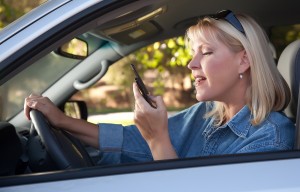Eyes on the Road, Not the Text
Serious risks are associated with disabled vehicles at the side of our nation’s highways. Safety patrol operators changing tires and fixing mechanical problems work just inches away from vehicles speeding down the road at 50-60-70 miles per hour.
For drivers a blink of an eye or a moment of distraction can result in a fatal mistake. It could be a drunk driver unable to control his/her vehicle. It could be an aggressive driver. Or, he/she could be distracted – talking, texting, surfing the web, watching videos or fiddling with the GPS. Whichever the case, distracted behavior born from bad judgment is often the direct cause of accidents. Seventy-five percent of fatal accidents are due to driver error according to the National Highway Traffic Safety Administration (NHTSA).
While Safety Service Patrols, through their rapid response to accidents and incidents, are effective in mitigating secondary accidents and restoring normal traffic flow- Safe Road Alliance is working to make our roads safer by keeping motorists focused on driving. Safe Roads Alliance is a non-profit working on a mission to promote better driving. Safe Roads Alliance maintains that crashes are preventable and that education and awareness are the keys to prevention. While it is very important to build safer cars, the safest car is one that doesn’t experience a crash. Improvements in design and advances in technology do lessen crash risks, but it remains the driver’s responsibility to avoid collisions.
Safe Roads Alliance provides licensed drivers with deep discounts to crash avoidance training classes that will help them drive more safely and to better avoid collisions. Teen drivers’ education does a good job of teaching our youth how to become drivers, however, becoming a good driver takes experience, on-going education and practice in controlled conditions.
Today dangerous driving is exacerbated by the insidious growth of communication gadgets, including cell phones, iPods, Blackberries and GPS units. More and more drivers are paying less and less attention to their driving. According to the National Safety Council, cell phone use is a factor in 6% of all crashes, which equates to 636,000 crashes, 330,000 injuries, 12,000 serious injuries and 2,600 deaths each year.
A 2008 study by the Insurance Institute for Highway Safety shows that drivers using cell phones are four times more likely to be involved in personal injury crashes than other drivers. Most crashes are caused by driver inattention, with cell phone use being the number one distraction. This finding, along with a 2008 poll by Nationwide Insurance showing that 81% of cell phone users report that they talk on their cell phone while driving and 18% of cell phone users report that they send text messages while driving, makes for highly volatile conditions.
According to research done by the Virginia Tech Transportation Institute, texting while driving increases the likelihood of a crash 22 times during the period that a driver is sending a text message. That’s not 22%. That is 2,200% increase.
Overcoming communication addiction and changing behavior accordingly are hugely challenging in terms of both public policy and driver education. An analogy can be drawn to seat belt use. Seat belts have been standard equipment in all American cars since 1971 when NHTSA mandated passive restraints and the laws requiring their use. Laws, which vary form state to state, have been on the books since 1984 when New York became the first state to require use. The compliance rate today is still only 83% according to NHTSA, even though thirteen out of 100 travelers run the risk of being hurled through a windshield.
Still, legislation is the place to start and legislation is an important tool to prevent drivers from engaging in unsafe distractions, such as cell phones and Internet devices. With or without laws, drivers can and must think about the consequences of their inattention and drive attentively. Along with programs such as Safety Service Patrols, Safe Roads Alliance is making every effort to reduce accidents.

